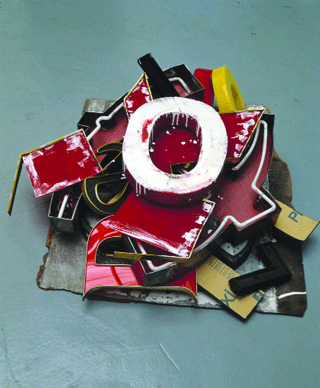Jack Pierson’s reminiscences celebrate the past, but with cynicism and angst
An exhibition of Jack Pierson’s early sculptures and installations, spanning two decades from 1982 to 2002, seems current again. Timelessness has been a constant undercurrent in his investigation into Americana lost. His text-based, found-letter and number sculptures—appropriated from commercial signage reminiscent of golden age Hollywood and Las Vegas and reassembled Scrabble-like to spell suggestive words or phrases—capture the hope and dreams of an America that at once seems exaltive and nostalgic. The same can be said for the current political and cultural scene and the talking heads on cable and in print who speak of “Empire” and global supremacy, which has more to do with a nostalgic view of America’s glory than with our future as a nation among others.
As a lesson it is apparent in Pierson’s early sculpture and installations that time does not pass and can be recaptured even as it degrades and is ultimately ephemeral. This is equally true of his photography for which Pierson is perhaps better known. Part of the so-called “Boston School” that included Nan Goldin and Mark Morrisroe, Pierson in those heady and innocent gym bunny days of the ‘90s, was often seen as the anti-Weber, that is Bruce, whose photographs of fresh-scrubbed, sweaky-clean youths whose self-confidence and optimism were at odds with Pierson’s terrestrial roster of often lackluster, thin, wan, and scrawny men. Moreover, Pierson’s fuzzy and blurred images and use of rich faded Technicolor glamour suggest a paradise lost in hazy Californian sunshine shot through a gauze of cynicism.
In Pierson’s current show, subtitled “Goodbye Yellowbrick Road,” a sense of decay, or good days gone bad, comes from the way in which the artist relies on nostalgia and memory to carry his message of erotic cynicism and cultural defeat. We often think that things were better way back when or back in the day. Pierson nudges us to reflect gladly on those memories yet reminds us that such musings are pleasurable nostalgic fantasies. In “Breakfast, Hope, Dinner, Fear” (1982), the signage looks like the menu board from a 1930s diner. Pierson presents an angst filled narrative wrapped in deliciously familiar cultural reminiscences.
Nostalgia for a vanished homosexual subculture shines in “Black Jackie” (1991), a small stage dripping with black rain curtain whose title refers to the word for queer used in the movie “Midnight Cowboy.” Less nostalgic and painfully present is “Goodbye Yellow Brick Road, Part II” (1990). Amber soap bars inscribed with the names of lovers known and lost compete with the urge to wash away the sickness, the pain, death, and sexuality which the inaction of ‘80s era AIDS public policy ushered in.
Pierson’s found-letter sculptures have won renown in art world circles. Often he arranges the letter to spell an evocative word or phrase. In a work such as “Paradise Lights” (1996), a site-specific work installed in the courtyard of the Museum of Contemporary Art in North Miami, MISSING WORD can be quite long even if judiciously spaced along a wall. In an effort to frustrate comprehension Pierson has turned to scattering or piling the letters on the gallery floor so that the only clue to deciphering the code is to read the wall text. “Psycho Killer” (2000) is comprised of colorful found letters, their rust, decay, and seemingly haphazard placement is as Hitchcockian as one can get to suggest horror, suspense, dread, and beauty. As grandiose as that work is in placement and narrative, “I (craked)” (1990) is sublime in its economy and Freudian allusion. The work is a succinct representation of a traumatized ego, trapped in the illusion of a glittering future yet dragged back to a painful reality.
gaycitynews.com



































